Lab Anim Res.
2014 Sep;30(3):112-122. 10.5625/lar.2014.30.3.112.
13-week subchronic toxicity study of a novel ginsenoside composition from ginseng leaves in rats
- Affiliations
-
- 1Department of Histology, College of Veterinary Medicine, Kyungpook National University, Daegu, Korea. psj26@knu.ac.kr
- 2Unigen Inc., Cheonan, Korea.
- KMID: 2312122
- DOI: http://doi.org/10.5625/lar.2014.30.3.112
Abstract
- UG0712 is a new ginsenoside extract processed from ginseng leaves. A subchronic toxicity study of UG0712 was conducted in male and female SD rats. Rats were treated with UG0712 at doses of 100, 400 and 1,600 mg/kg/day for 13 weeks, and observed followed by 4-week recovery period at a highest dose. No-treatment-related effects were observed regarding the mortality, ophthalmic examination, urinalysis and histopathology. Although the changes in clinical sign, body weight, organ weight, hematology, and serum biochemistry were observed, they were temporal and pharmacological effects. Based on the present experiment conditions, the no observed adverse effect level was considered to be more than 1,600 mg/kg/day in both sexes of rats.
Keyword
MeSH Terms
Figure
Reference
-
1. Yun TK. Brief introduction of Panax ginseng C.A. Meyer. J Korean Med Sci. 2001; 16(Suppl):S3–S5. PMID: 11748372.
Article2. Kiefer D, Pantuso T. Panax ginseng. Am Fam Physician. 2003; 68(8):1539–1542. PMID: 14596440.3. Leung KW, Wong AS. Pharmacology of ginsenosides: a literature review. Chin Med. 2010; 5:20. PMID: 20537195.
Article4. Kim HS, Lee EH, Ko SR, Choi KJ, Park JH, Im DS. Effects of ginsenosides Rg3 and Rh2 on the proliferation of prostate cancer cells. Arch Pharm Res. 2004; 27(4):429–435. PMID: 15180309.
Article5. Kim DH, Chung JH, Yoon JS, Ha YM, Bae S, Lee EK, Jung KJ, Kim MS, Kim YJ, Kim MK, Chung HY. Ginsenoside Rd inhibits the expressions of iNOS and COX-2 by suppressing NF-κB in LPS-stimulated RAW264.7 cells and mouse liver. J Ginseng Res. 2013; 37(1):54–63. PMID: 23717157.
Article6. Hu G, Wu Z, Yang F, Zhao H, Liu X, Deng Y, Shi M, Zhao G. Ginsenoside Rd blocks AIF mitochondrio-nuclear translocation and NF-κB nuclear accumulation by inhibiting poly(ADP-ribose) polymerase-1 after focal cerebral ischemia in rats. Neurol Sci. 2013; 34(12):2101–2106. PMID: 23463404.
Article7. Tian J, Fu F, Geng M, Jiang Y, Yang J, Jiang W, Wang C, Liu K. Neuroprotective effect of 20(S)-ginsenoside Rg3 on cerebral ischemia in rats. Neurosci Lett. 2005; 374(2):92–97. PMID: 15644271.
Article8. Tian J, Zhang S, Li G, Liu Z, Xu B. 20(S)-ginsenoside Rg3, a neuroprotective agent, inhibits mitochondrial permeability transition pores in rat brain. Phytother Res. 2009; 23(4):486–491. PMID: 19003949.
Article9. Chai H, Do S, Kim J, Kim D, Sung S, Lee Y, Woo S, Kang J. UG0712, a novel ginsenoside composition enhances the endurance exercise capacity and fatigue recovery. Lab Anim Res. 2009; 25:207–212.10. Chan PC, Peckham JC, Malarkey DE, Kissling GE, Travlos GS, Fu PP. Two-year toxicity and carcinogenicity studies of Panax ginseng in Fischer 344 rats and B6C3F1 mice. Am J Chin Med. 2011; 39(4):779–788. PMID: 21721156.
Article11. Liu JP, Lu D, Nicholson RC, Li PY, Wang F. Toxicity of a novel anti-tumor agent 20(S)-ginsenoside Rg3: a 26-week intramuscular repeated administration study in Beagle dogs. Food Chem Toxicol. 2011; 49(8):1718–1727. PMID: 21540070.
Article12. Liu JP, Lu D, Nicholson RC, Zhao WJ, Li PY, Wang F. Toxicity of a novel anti-tumor agent 20(S)-ginsenoside Rg3: a 26-week intramuscular repeated administration study in rats. Food Chem Toxicol. 2012; 50(10):3388–3396. PMID: 22819934.
Article13. Lu D, Liu J, Zhao W, Li P. Chronic toxicity of ginsenoside Re on Sprague-Dawley rats. J Ethnopharmacol. 2012; 144(3):656–663. PMID: 23063957.
Article14. Wan JB, Yang FQ, Li SP, Wang YT, Cui XM. Chemical characteristics for different parts of Panax notoginseng using pressurized liquid extraction and HPLC-ELSD. J Pharm Biomed Anal. 2006; 41(5):1596–1601. PMID: 16522361.
Article15. Wang CZ, Wu JA, McEntee E, Yuan CS. Saponins composition in American ginseng leaf and berry assayed by high-performance liquid chromatography. J Agric Food Chem. 2006; 54(6):2261–2266. PMID: 16536605.
Article16. Gu Y, Wang GJ, Sun JG, Jia YW, Wang W, Xu MJ, Lv T, Zheng YT, Sai Y. Pharmacokinetic characterization of ginsenoside Rh2, an anticancer nutrient from ginseng, in rats and dogs. Food Chem Toxicol. 2009; 47(9):2257–2268. PMID: 19524010.
Article17. Kim U, Park MH, Kim DH, Yoo HH. Metabolite profiling of ginsenoside Re in rat urine and faeces after oral administration. Food Chem. 2013; 136(3-4):1364–1369. PMID: 23194536.
Article18. Aphale AA, Chhibba AD, Kumbhakarna NR, Mateenuddin M, Dahat SH. Subacute toxicity study of the combination of ginseng (Panax ginseng) and ashwagandha (Withania somnifera) in rats: a safety assessment. Indian J Physiol Pharmacol. 1998; 42(2):299–302. PMID: 10225062.19. Yang KS, Kim YK, Park SB. Studies on the anion contents in crude drugs. Korean J Pharmacogn. 1989; 20(1):64.
- Full Text Links
- Actions
-
Cited
- CITED
-
- Close
- Share
- Similar articles
-
- Production of Ginsenoside-Rg3 from Lipomyces starkeyi Grown on Ginseng-Steaming Effluent
- The Comparison of Seasonal Ginsenoside Composition Contents in Korean Wild Simulated Ginseng (Panax ginseng) which were Cultivated in Different Areas and Various Ages
- Subacute Oral Toxicity Study of Korean Red Ginseng Extract in Sprague-Dawley Rats
- The Change of Ginsenoside Composition in the Ginseng (Panax ginseng) Flower Buds by the Ultrasonication and Vinegar Process
- Subchronic Inhalation Toxicity Study of n-pentane in Rats


